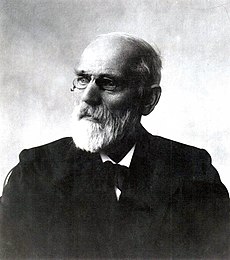Johannes Diderik van der Waals
| Johannes van der Waals | |
|---|---|
 |
|
| Born |
23 November 1837 Leiden, Netherlands |
| Died | 8 March 1923 (aged 85) Amsterdam, Netherlands |
| Nationality | Dutch |
| Fields | Theoretical physics, thermodynamics |
| Institutions | University of Amsterdam |
| Alma mater | University of Leiden |
| Doctoral advisor | Pieter Rijke |
| Doctoral students |
Diederik Korteweg Willem Hendrik Keesom |
| Known for | Laying the foundations for modern molecular physics (molecular theory) Originating modern theory of intermolecular forces (van der Waals forces) Law of corresponding states Real gas law (van der Waals equation of state) van der Waals radius van der Waals surface van der Waals molecule |
| Influences |
Rudolf Clausius Ludwig Boltzmann Josiah Willard Gibbs Thomas Andrews |
| Influenced |
Heike Kamerlingh Onnes Willem Hendrik Keesom Peter Debye Zygmunt Florenty Wróblewski James Dewar Fritz London |
| Notable awards | Nobel Prize for Physics (1910) |
Johannes Diderik van der Waals (Dutch: [joːˈɦɑnəz ˈdidəˌrɪk fɑn dɛr ˈʋaːls]; 23 November 1837 – 8 March 1923) was a Dutch theoretical physicist and thermodynamicist famous for his work on an equation of state for gases and liquids.
His name is primarily associated with the van der Waals equation of state that describes the behavior of gases and their condensation to the liquid phase. His name is also associated with van der Waals forces (forces between stable molecules), with van der Waals molecules (small molecular clusters bound by van der Waals forces), and with van der Waals radii (sizes of molecules). As James Clerk Maxwell said about Van der Waals, "there can be no doubt that the name of Van der Waals will soon be among the foremost in molecular science."
In his 1873 thesis, van der Waals noted the non-ideality of real gases and attributed it to the existence of intermolecular interactions. Spearheaded by Ernst Mach and Wilhelm Ostwald, a strong philosophical current that denied the existence of molecules arose towards the end of the 19th century. The molecular existence was considered unproven and the molecular hypothesis unnecessary. At the time van der Waals' thesis was written (1873), the molecular structure of fluids had not been accepted by most physicists, and liquid and vapor were often considered as chemically distinct. But Van der Waals's work affirmed the reality of molecules and allowed an assessment of their size and attractive strength. By comparing his equation of state with experimental data, Van der Waals was able to obtain estimates for the actual size of molecules and the strength of their mutual attraction. The effect of Van der Waals's work on molecular physics in the 20th century was direct and fundamental. By introducing parameters characterizing molecular size and attraction in constructing his equation of state, Van der Waals set the tone for modern molecular science. That molecular aspects such as size, shape, attraction, and multipolar interactions should form the basis for mathematical formulations of the thermodynamic and transport properties of fluids is presently considered an axiom. With the help of the van der Waals's equation of state, the critical-point parameters of gases could be accurately predicted from thermodynamic measurements made at much higher temperatures. Nitrogen, oxygen, hydrogen, and helium subsequently succumbed to liquefaction. Heike Kamerlingh Onnes was significantly influenced by the pioneer work of van der Waals. In 1908, Onnes became the winner of the race to make liquid helium and because of this, he was also to be the discoverer of superconductivity in 1911.
...
Wikipedia
